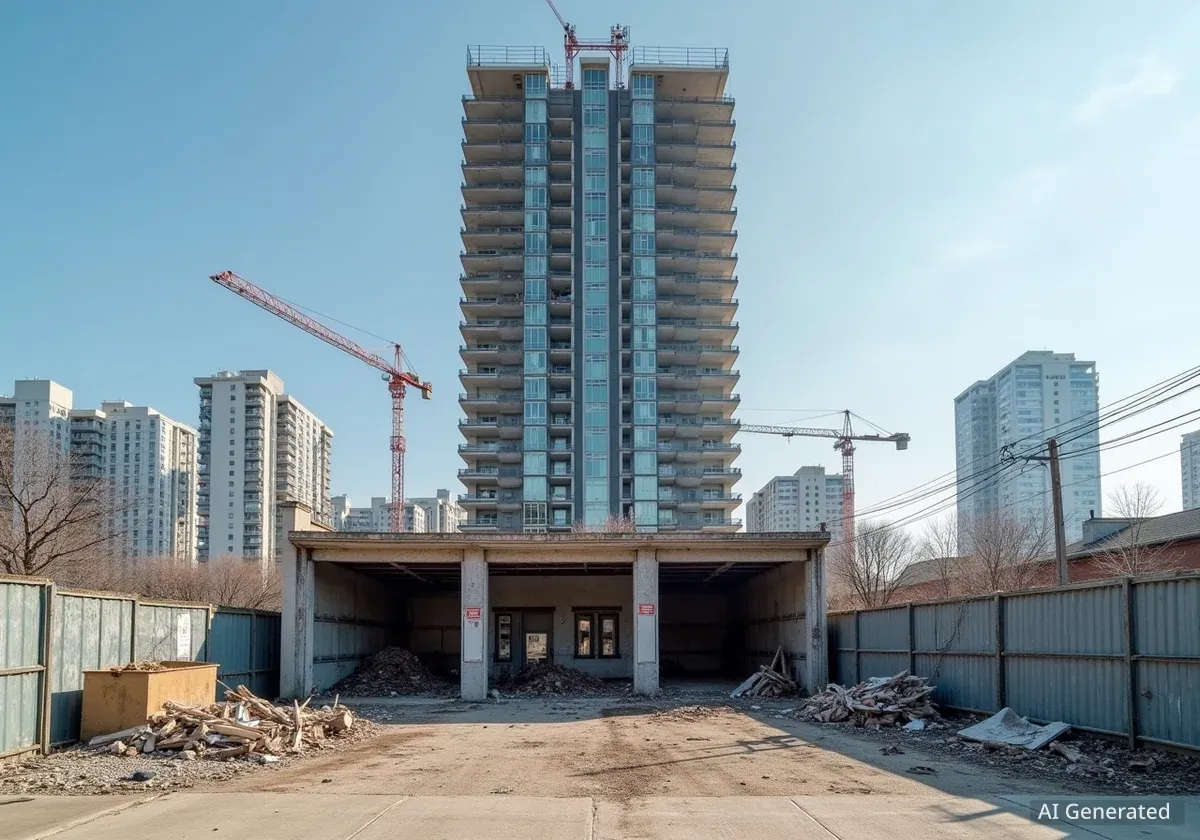Boston's real estate development is increasingly a tale of two cities. Driven by some of the nation's highest construction costs, developers are focusing on two extremes: ultra-luxury condominiums and government-subsidized affordable housing. This leaves a widening gap in the market, making it nearly impossible for middle-income residents to find a place to live in the city they serve.
The phenomenon, often called the "missing middle," is creating a difficult situation for essential workers like teachers, nurses, and first responders. As developers find it economically unfeasible to build for this demographic, the city risks losing the very people who form its backbone.
Key Takeaways
- High construction costs in Boston make building middle-income housing unprofitable for developers.
- New construction is largely split between high-end luxury units and subsidized affordable housing.
- Middle-income households, including essential workers, are being priced out of the city.
- This market dynamic threatens Boston's economic diversity and long-term stability.
The Root of the Problem: Sky-High Construction Costs
Building in Boston is one of the most expensive undertakings in the United States. A combination of factors has created a perfect storm, pushing development costs so high that only projects with the highest profit margins—or those with significant public subsidies—are viable.
Several key elements contribute to these elevated expenses. The cost of land is a primary driver, with available parcels in desirable neighborhoods commanding premium prices. Beyond the land itself, developers face a challenging regulatory environment that can add time and money to any project.
Why Building is So Expensive
The high costs are not due to a single factor but a combination of pressures on developers. These include:
- Labor Costs: Boston is a strong union city with highly skilled, and therefore expensive, labor pools.
- Material Prices: Supply chain disruptions have kept the cost of essential building materials like steel, lumber, and concrete persistently high.
- Land Scarcity: As a historic and geographically constrained city, Boston has limited land available for new, large-scale development.
- Regulatory Hurdles: A complex and lengthy permitting and zoning approval process can add significant overhead and uncertainty to project timelines.
These combined costs create a high baseline for any new construction. For a project to be profitable, the final sale price or rental income must be substantial enough to cover these initial outlays and provide a return for investors. This economic reality is what pushes developers away from the middle market.
A Market of Two Extremes
The financial pressures on developers have resulted in a bifurcated housing market. On one end, there is a consistent demand for luxury housing from high-income professionals, international buyers, and empty-nesters. These projects, featuring high-end finishes and extensive amenities, can command prices that easily justify the high construction costs.
On the other end of the spectrum is subsidized housing. These projects are made possible through a web of city, state, and federal programs, including tax credits and direct funding. While essential for low-income residents, these developments do not address the needs of those who earn too much to qualify for assistance but not enough to afford market-rate housing.
The Economic Calculation
Industry experts note that the cost to build a modest, middle-income apartment unit is not significantly lower than the cost to build a luxury one. The primary differences are in the interior finishes and amenities, which represent a relatively small portion of the total project budget. Given the similar upfront costs, developers naturally gravitate toward the luxury market where potential returns are much higher.
This leaves the middle market almost entirely unserved by new construction. It is simply not profitable for a developer to spend millions on a project to sell or rent units at a price point that a teacher or a firefighter could afford.
The Human Impact of the 'Missing Middle'
The consequences of this housing gap are profound and deeply personal for many Bostonians. The term "middle-income" in Boston can refer to households earning between 80% and 120% of the Area Median Income (AMI), which can be a substantial figure but is often insufficient to compete in the city's housing market.
This group includes many of the city's most vital workers:
- Nurses and Healthcare Staff: The professionals who staff Boston's world-class hospitals.
- Public School Teachers: Educators who shape the next generation of city residents.
- Police Officers and Firefighters: First responders who ensure the city's safety.
- Non-Profit and Municipal Employees: The people who run the city's essential services.
When these individuals cannot afford to live in or near the community they serve, it creates a host of secondary problems. Long commutes lead to traffic congestion and reduced quality of life. More importantly, it can lead to a disconnect between public servants and the communities they work in.
"We are at risk of becoming a city that is only accessible to the very wealthy and those who receive significant housing assistance," one urban planner commented. "A healthy city needs a strong middle class. Without housing for them, we lose our economic diversity and our community fabric."
Searching for Solutions
Addressing the "missing middle" housing crisis is a complex challenge with no easy answers. City officials and urban planners are exploring a range of strategies aimed at making middle-income housing more economically feasible to build.
Potential Policy Interventions
Some of the solutions being discussed include streamlining the permitting process to reduce project timelines and costs. Others advocate for zoning reforms that would allow for denser construction, such as building more multi-family units in neighborhoods currently dominated by single-family homes. This could increase the housing supply and potentially lower per-unit costs.
Public-private partnerships are also being considered, where the city might offer incentives like tax abatements or access to public land for developers who commit to building housing for middle-income residents. However, each of these solutions comes with its own set of political and logistical challenges.
Ultimately, the situation in Boston highlights a growing problem in major American cities. Without deliberate and creative intervention, the housing market will continue to cater to the extremes, leaving the middle class with fewer options and forcing them to look for homes far beyond the city limits.





